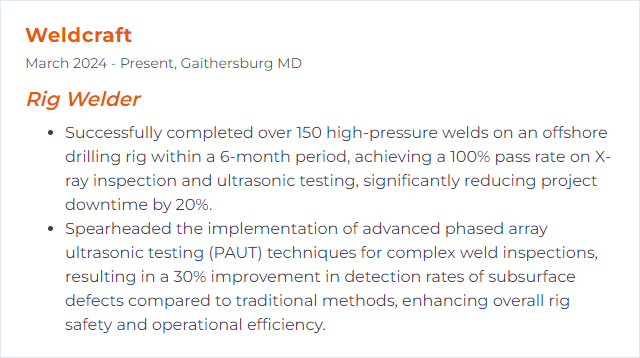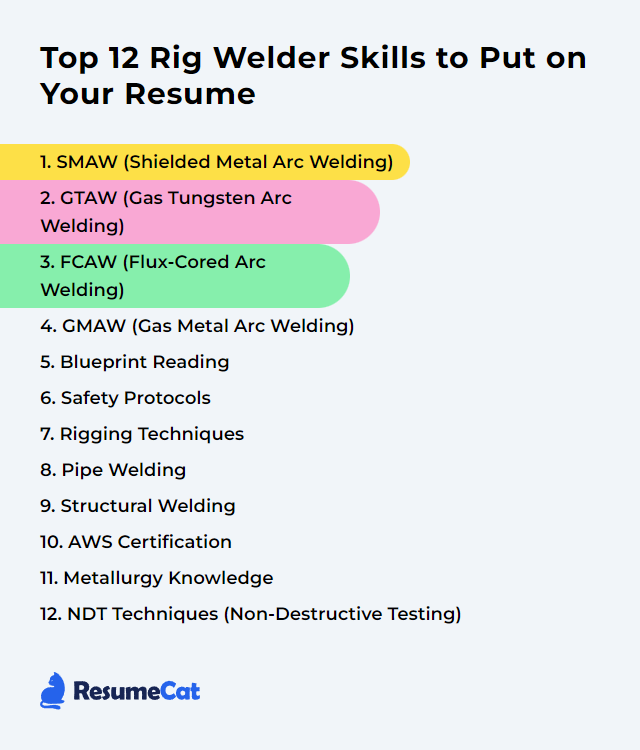Top 12 Rig Welder Skills to Put on Your Resume
Rig welding jobs don’t forgive flimsy skill sets. Hiring managers skim fast and judge faster, so the right mix of technical depth, safety focus, and field-ready versatility matters. The twelve skills below earn their keep on real rigs, in real weather, with real deadlines.
Rig Welder Skills
- SMAW (Shielded Metal Arc Welding)
- GTAW (Gas Tungsten Arc Welding)
- FCAW (Flux-Cored Arc Welding)
- GMAW (Gas Metal Arc Welding)
- Blueprint Reading
- Safety Protocols
- Rigging Techniques
- Pipe Welding
- Structural Welding
- AWS Certification
- Metallurgy Knowledge
- NDT Techniques (Non-Destructive Testing)
1. SMAW (Shielded Metal Arc Welding)
SMAW uses a flux‑coated consumable electrode to create a weld, and it thrives where wind, rust, and rough fit-up try to get in the way. From E6010 root passes to low‑hydrogen cap work, it’s the all-weather, all-attitude standby for field repairs and new installs.
Why It's Important
SMAW brings portability, tolerance for less‑than‑perfect conditions, and strong, code-worthy welds. On rigs with tight access and shifting conditions, that combination keeps projects moving and structures honest.
How to Improve SMAW (Shielded Metal Arc Welding) Skills
Dial in amperage: Match current to electrode type and diameter; keep arc length roughly equal to the rod’s core diameter.
Choose electrodes wisely: Cellulosic (e.g., 6010/6011) for deep-penetrating roots and dirty steel; low-hydrogen (7018) for structural work and crack resistance.
Keep it clean: Grind, wire brush, and decontaminate surfaces; moisture and paint invite porosity and lack of fusion.
Master positions: Flat, horizontal, vertical up, overhead—practice whip-and-pause for open roots and steady weave for fills/caps.
Control heat: Watch puddle wet-out, maintain interpass temperatures, and stagger passes to manage distortion.
Mind storage: Keep 7018s dry and baked; swap out damp rods immediately.
Tame arc blow: Adjust ground location and travel direction; shorten arc length when magnetic forces misbehave.
Refine the basics, then refine them again. Your bead will tell you what it thinks.
How to Display SMAW (Shielded Metal Arc Welding) Skills on Your Resume
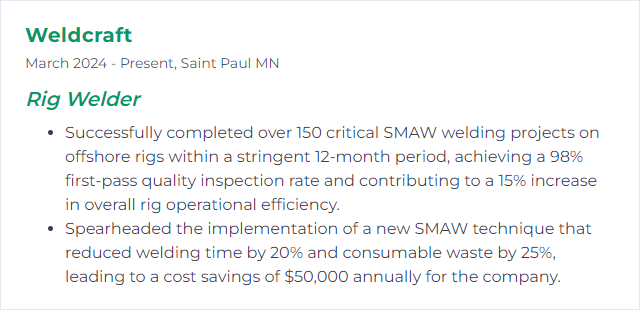
2. GTAW (Gas Tungsten Arc Welding)
GTAW uses a non‑consumable tungsten electrode with inert shielding gas to produce precise, clean welds. It’s the go‑to for thin sections, critical roots, and alloys where appearance and integrity both matter.
Why It's Important
When the spec calls for surgical control, minimal spatter, and tight heat input, GTAW delivers. Think stainless roots, exotic alloys, valve tie-ins—places where sloppy simply cannot pass.
How to Improve GTAW (Gas Tungsten Arc Welding) Skills
Prepare like a hawk: Degrease, clean, and fit with care; GTAW punishes contamination.
Sharpen and size tungsten: Consistent tip geometry, correct diameter, and proper alloy (e.g., 2% lanthanated) stabilize the arc.
Shielding control: Typical argon flow 15–20 CFH; use larger cups, gas lenses, and proper stick-out for broader coverage. Back-purge stainless and duplex when required.
Consistent motion: Short, steady arc length; keep filler within the shield; avoid dipping tungsten.
Pulse and heat: Use pulsed GTAW to manage heat input on thin material; let interpass temps drop as procedures demand.
Comfort equals quality: Foot pedal or fingertip amperage control, stable bracing, and good ergonomics raise your ceiling fast.
How to Display GTAW (Gas Tungsten Arc Welding) Skills on Your Resume
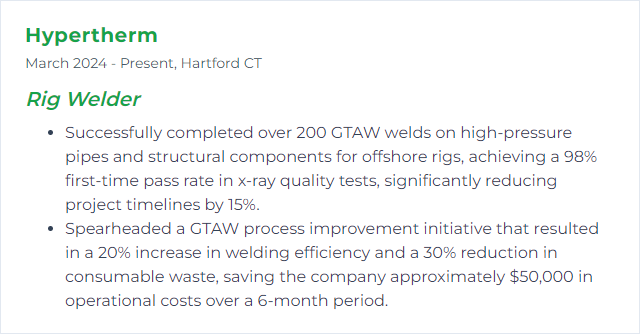
3. FCAW (Flux-Cored Arc Welding)
FCAW feeds a tubular wire packed with flux. Self‑shielded wire shrugs off wind; gas‑shielded wire boosts deposition and arc stability. It’s quick, it penetrates well, and it carries slag—so cleanup is part of the deal.
Why It's Important
High productivity with strong mechanicals, even outdoors. For structural work and heavy sections, FCAW keeps schedules honest without sacrificing quality.
How to Improve FCAW (Flux-Cored Arc Welding) Skills
Match wire to the job: FCAW‑S for windy sites; FCAW‑G for cleaner beads and higher deposition when shielded areas allow.
Set parameters smartly: Tune voltage and wire feed for transfer mode and position; don’t chase spatter—fix the root cause.
Stick-out discipline: About 3/4–1 in for FCAW‑S; 1/2–5/8 in for FCAW‑G. Control equals stability.
Use the right technique: Drag on fillets and grooves; maintain a consistent travel angle and speed to avoid cold lap.
Surface and wind: Clean base metal; block drafts; verify gas flow when using FCAW‑G.
Manage heat: Preheat where required, watch interpass temps, and balance sequence to limit distortion.
Chip and brush: Remove slag thoroughly between passes to keep inclusions out.
How to Display FCAW (Flux-Cored Arc Welding) Skills on Your Resume
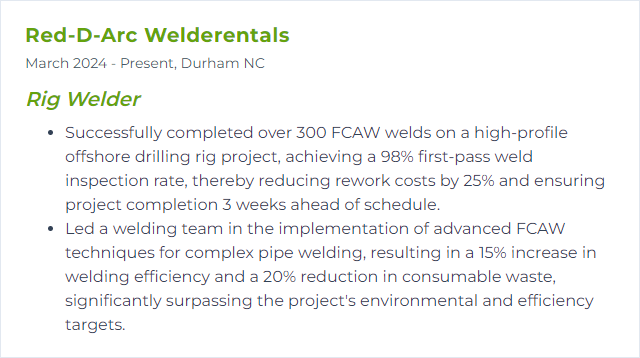
4. GMAW (Gas Metal Arc Welding)
GMAW uses a solid wire and shielding gas. Short-circuit, spray, and pulsed modes each have a lane. It shines in shop or sheltered field work, and with the right setup, it’s fast and clean.
Why It's Important
Versatility across steels and alloys, strong deposition rates, and minimal post‑weld cleanup in controlled conditions—all good for throughput and consistency.
How to Improve GMAW (Gas Metal Arc Welding) Skills
Pick your mode: Short-circuit for thin or out-of-position, spray/pulsed for thicker sections and flat/horz productivity.
Wire and gas pairing: Size the wire to the job; typical steel mixes lean on argon/CO2. Flow rates in the 20–30 CFH range are common—verify by procedure and conditions.
CTWD matters: Keep a steady contact tip-to-work distance to stabilize the arc and bead shape.
Angle and travel: About 10–15° push for cleaner beads and better visibility; adjust for penetration and position.
Maintain the gun: Replace tips and liners before they cause feeding issues; keep nozzles clean to protect the gas envelope.
Watch heat input: Manage interpass temperatures and sequence to curb distortion and meet procedure limits.
How to Display GMAW (Gas Metal Arc Welding) Skills on Your Resume
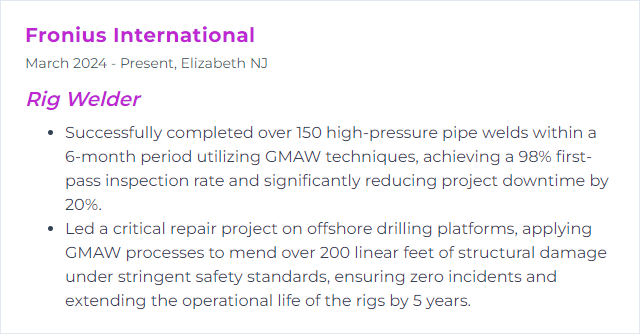
5. Blueprint Reading
Blueprint reading means parsing symbols, notes, and views so the work in front of you matches the drawing behind it. Spools, isometrics, weld symbols, tolerances—put the puzzle together before the first arc strikes.
Why It's Important
Misread drawings burn time, money, and sometimes steel. Accurate interpretation anchors fit‑up, sequence, and inspection to spec.
How to Improve Blueprint Reading Skills
Learn the language: Weld symbols per AWS A2.4, finish marks, contours, and tail data—know them cold.
Chase dimensions: Understand tolerances, datums, and GD&T basics that affect fit-up and inspection.
Multiple views: Translate orthographic and isometric views into a 3D mental model; trace load paths and weld sequences.
Codes and procedures: Map drawings to the correct WPS/PQR and acceptance criteria (e.g., AWS D1.1, API 1104, ASME IX).
Repetition: Review old jobs, redlines, and as‑builts; nothing teaches like solved problems.
Targeted training: Short courses, shop walkthroughs, and mentor-led reviews beat guesswork.
How to Display Blueprint Reading Skills on Your Resume
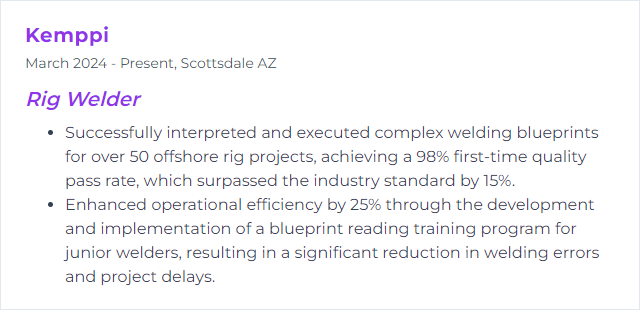
6. Safety Protocols
Safety on rigs wraps PPE, hot work control, ventilation, gas handling, confined space rules, and emergency readiness into one relentless habit. The work is hot, loud, and unforgiving—systems keep people whole.
Why It's Important
High-energy tasks near flammables and pressure systems raise the stakes. Good protocols cut injury, downtime, and rework. Great ones save lives.
How to Improve Safety Protocols Skills
Train and retrain: Welding safety, hazard recognition, H2S awareness, fire watch, and first aid—refreshers stick.
Inspect relentlessly: Torches, guns, leads, cylinders, regulators, PPE—tag, fix, or pull from service before they bite.
Control the environment: Ventilate fumes, manage sparks, clear combustibles, and post a hot-work permit where it counts.
Plan for bad days: Drill emergency response, egress paths, and communication; stage extinguishers and spill kits.
Lockout/Tagout and confined space: Verify energy isolation, gas testing, rescue plans, and standby attendants.
Heat, noise, and UV: Shade selection, FR clothing, hearing protection, hydration, and rest cycles—simple, vital.
How to Display Safety Protocols Skills on Your Resume
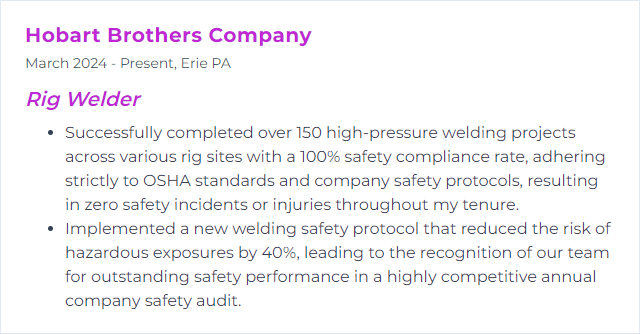
7. Rigging Techniques
Rigging techniques cover how to lift, position, and secure heavy pieces so welding can happen safely. Slings, shackles, spreader bars, cranes—plus the math and patience to use them correctly.
Why It's Important
One bad lift can ruin equipment, schedules, or worse. Good rigging turns chaos into choreography.
How to Improve Rigging Techniques Skills
Know the rules: ASME and OSHA guidance, site policies, and manufacturer ratings set the boundaries—respect them.
Plan the lift: Load weight, center of gravity, sling angles, D/d ratios, and tag-line control—plan first, lift once.
Inspect gear: Slings, hooks, shackles, and spreaders—reject cuts, kinks, deformation, or worn hardware.
Communicate: Standard hand signals and one clear spotter; no guesswork on the ground or at height.
Protect edges: Use softeners and corner guards; sling damage is sneaky and expensive.
Practice positioning: Set components with alignment in mind; faster fit-up, fewer pry bars, safer hands.
How to Display Rigging Techniques Skills on Your Resume
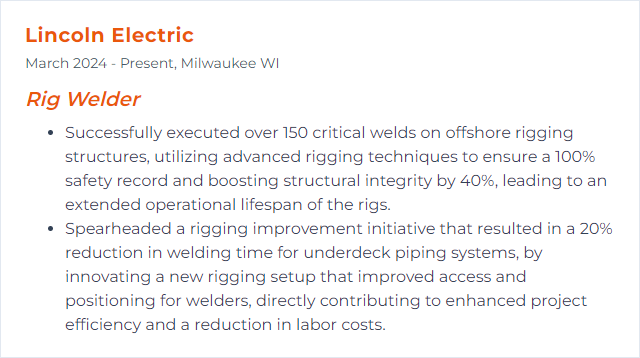
8. Pipe Welding
Pipe welding joins pressure systems that move oil, gas, water, and chemicals. Roots, hot passes, fills, and caps across carbon, stainless, and alloy steels—often out of position, often critical.
Why It's Important
Small defects can grow into leaks, shutdowns, or hazards. Tight procedures and steady hands keep lines sound.
How to Improve Pipe Welding Skills
Own the positions: 1G through 6G—especially 5G/6G—until body memory takes over.
Root choice and prep: Open root with GTAW or cellulosic SMAW; set land and gap, feather tacks, and keep alignment tight.
Purge when needed: Stainless and duplex demand clean internal gas shielding for roots and heat tint control.
Control heat input: Track interpass temperatures; avoid excessive reinforcement and undercut; meet procedure windows.
Code awareness: API 1104 and ASME IX acceptance criteria are not twins—learn the differences.
Fit-up habits: Use hi‑lo clamps and bridges; stagger tacks; balance shrinkage as you climb.
How to Display Pipe Welding Skills on Your Resume
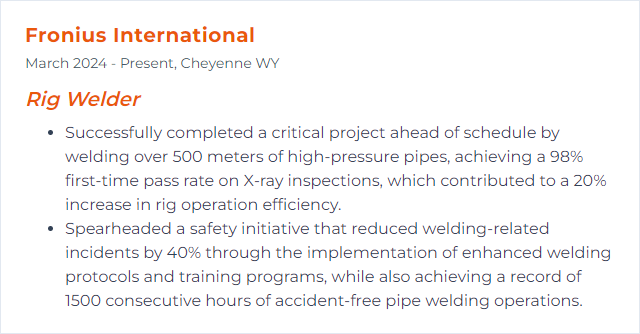
9. Structural Welding
Structural welding ties together beams, nodes, braces, and deck steel so rigs stay rigid and predictable. Conditions vary, loads don’t care, and codes set the bar.
Why It's Important
Integrity under dynamic loads is the whole game. Strong connections prevent progressive failures that don’t give second chances.
How to Improve Structural Welding Skills
Follow the code: AWS D1.1 and related standards define fit-up, preheat, and acceptance. Work inside those lines.
Low-hydrogen discipline: Store and handle 7018 properly; keep moisture away to dodge hydrogen cracking.
Preheat smart: Base it on thickness and carbon equivalent; verify with temp crayons or meters.
Sequence for straightness: Stitch, backstep, and balance to minimize distortion and residual stress.
Inspect as you go: VT every pass; MT/UT/RT as required; fix indications before they stack up.
Weather calls: Wind, rain, and temperature limits are real—shelter or stop when conditions cross the line.
How to Display Structural Welding Skills on Your Resume
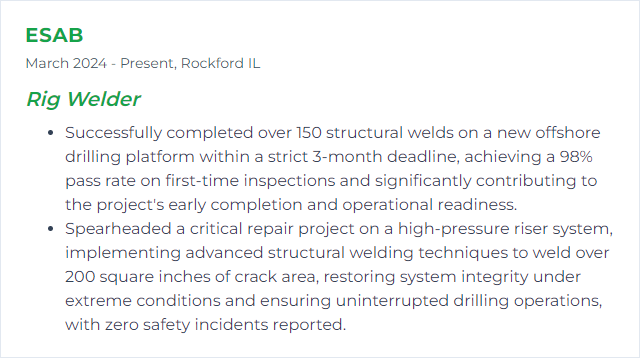
10. AWS Certification
AWS welder qualifications validate your ability to deposit sound welds to specific code requirements. Not cloud computing—American Welding Society credentials tied to real procedures and tests.
Why It's Important
Third‑party proof your welds meet code. It opens gates on job sites and keeps quality managers comfortable signing off.
How to Improve AWS Certification Skills
Pick the right test: Target processes and positions you use most (e.g., SMAW 3G/4G for structural, GTAW/SMAW combo for pipe).
Study the code: Know the acceptance criteria, essential variables, and limits for AWS D1.1, API 1104, or ASME IX as specified.
Practice to a WPS: Mirror test conditions—base metal, filler, joint design, and parameters—so there are no surprises.
Maintain continuity: Log qualifying process use at least every six months to keep tests current.
Document everything: Keep WPS, PQR, and WPQ/WQTR copies organized for quick submittals.
Seek feedback: Run mock tests with an experienced CWI observing; fix what they flag before test day.
How to Display AWS Certification Skills on Your Resume
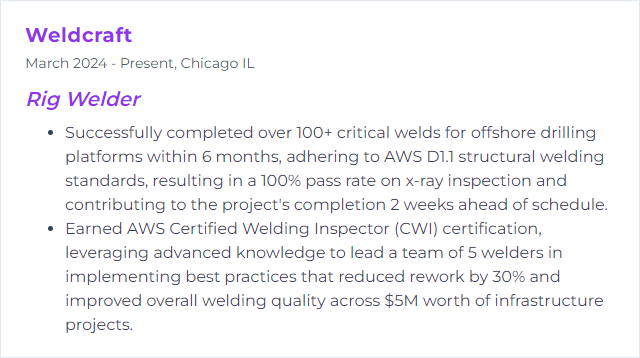
11. Metallurgy Knowledge
Metallurgy is the why behind the weld. Heat-affected zones, hydrogen cracking, carbon equivalent, tempering, toughness—understanding the metal’s mood makes better choices.
Why It's Important
Material behavior under heat and load drives procedure limits, preheat, filler selection, and post‑weld treatment. Guessing here is expensive.
How to Improve Metallurgy Knowledge Skills
Carbon equivalent: Learn CE formulas and how they influence preheat and cracking risk.
HAZ awareness: Recognize microstructural changes, hard zones, and how interpass control softens the blow.
Consumable matching: Pick filler metals for strength, toughness, and chemistry compatibility—especially for low‑temp service.
PWHT and temper bead: When to stress relieve, how long, and how to temper hard zones without a furnace when allowed.
Material groupings: Know P‑Numbers, F‑Numbers, and A‑Numbers; they steer procedure and qualification rules.
Corrosion concerns: Galvanic pairs, chloride stress cracking, and heat tint removal on stainless—small oversights, big consequences.
How to Display Metallurgy Knowledge Skills on Your Resume
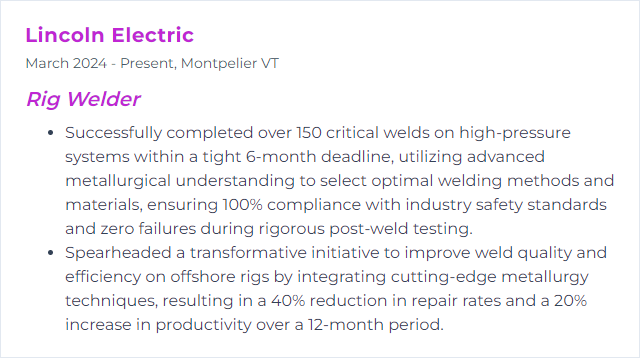
12. NDT Techniques (Non-Destructive Testing)
NDT checks weld quality without cutting anything apart. Visual, PT, MT, UT, RT, and advanced flavors like PAUT and TOFD—all tools to spot flaws before they become failures.
Why It's Important
Rigs run hard. Early detection of porosity, lack of fusion, cracks, or inclusions prevents rework, leaks, and unplanned downtime.
How to Improve NDT Techniques (Non-Destructive Testing) Skills
Method mastery: Know what each method sees (surface vs subsurface) and its limitations. Use the right tool, not just the available one.
Calibrate and care: Maintain equipment, use proper reference blocks, and verify sensitivity before inspections start.
Lighting and prep: For VT and PT, surface cleanliness and adequate illumination are non‑negotiable.
Interpretation, not imagination: Distinguish indications from rejectable defects per the governing code.
Records matter: Traceable reports, clear photos, and marked-up drawings speed approvals and repairs.
Keep learning: Refresh certifications, shadow seasoned technicians, and stay current on evolving techniques like phased array.
How to Display NDT Techniques (Non-Destructive Testing) Skills on Your Resume
